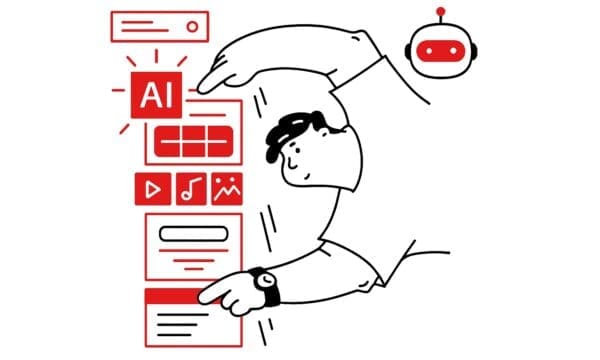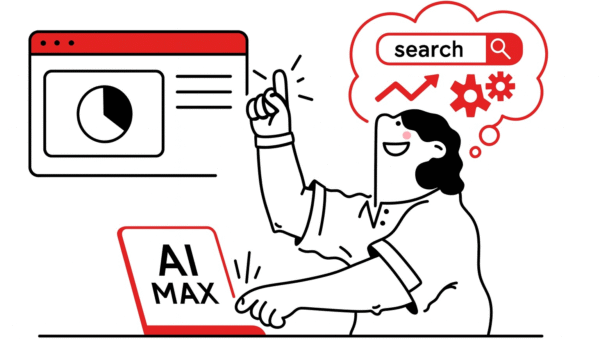LLM-driven development rewrites the rules

AI makes things easier. That’s obvious. But the real change is not that AI
We build, write and create with an extra pair of thinking hands. Humans remain at the wheel; AI helps pave the way. To this end, an LLM (Large Language Model) is a fundamental part of this new way of working. An LLM is an advanced language model that, through techniques such as retrieval augmented generation and prompt engineering, is essential for building AI-driven applications such as chatbots and search engines. It drives many AI-driven systems and requires specific engineering and quality criteria.
In software development, this is perhaps most evident. Where we once wrote code line by line, we can now have entire functions built with a sentence, idea or prompt. This approach makes it possible to develop applications faster and easier using AI. That shift is called LLM-driven development, and it literally rewrites the rules.
From no-code to LLM-driven
It started with no-code. Tools like Webflow and Zapier allowed anyone to build anything without programming knowledge. Then came low-code, which allowed developers to work faster by combining visual building blocks with proprietary logic.
But the real revolution began with the emergence of large language models (LLMs) such as ChatGPT, Claude and Gemini. They understand natural language, write code, document processes and improve themselves. In this new development process, the LLM plays a central role as a core component that drives the entire process. This makes it possible to realize complex software solutions faster and more efficiently. As a result, software development is no longer purely technical, but has also become linguistic.
With LLM-driven development, you no longer work in the code, but with the model. This approach leads to building more sophisticated systems that bring together prompts, models and interfaces. You describe what you want “create a web app that displays customer data and can generate exports” and the AI writes the basics. You check, refine, think along – it’s not just about writing code, but also designing processes and workflows.
What is LLM-driven development?
LLM-driven development means that a large language model is the central partner in the development process. This revolves around building llm-based solutions, where systems are designed and developed based on large language models. LLMs can automatically generate test cases and test data based on functional requirements or existing code, which further accelerates and optimizes the development process.
The model:
- understands natural language (your description or prompt),
- generates working code,
- can explain what that code does,
- and learn from feedback or corrections.
Humans set direction, control quality, and monitor context. AI executes, tests, and sometimes even suggests improvements. This approach makes it possible to quickly prototype to build and develop solutions, allowing individuals or teams to go from idea to prototype much faster.
In short: You no longer write rules, but you write the instructions used to write the rules. This offers mainly practical advantages, such as immediate applicability and efficiency in the development process.
Key terms explained in plain language
No-code
You build without code. Everything is done via drag-and-drop in a visual environment. Examples: Webflow, Zapier, Softr.
One example: using a no-code tool like Zapier, you can easily automate a workflow that automatically notifies customers to return orders within 14 days.
Low-code
You use blocks and logic, but can still add your own code. Examples: Retool, Bubble, Outsystems.
LLM-assisted development
You work with an AI when writing, improving or testing code. Examples: GitHub Copilot, Replit Ghostwriter, Codeium.
LLM-driven development
The AI is not just helper, but the engine. You describe the goal, the AI builds the structure. In this context, the AI acts as an “agent” that can independently perform and coordinate tasks within complex AI systems. Examples: Cursor, Lovable, v0.dev, Claude.
Vibe coding
Term coined by Andrej Karpathy. You “talk” to the AI until the result feels right, without reading every line of code. The AI tests, corrects and learns from the feedback loop.
Prompt engineering
The art of properly instructing an AI model. A good prompt is the new form of programming: the more precise your prompt, the better the result. You can also create prompts from external sources, such as existing datasets or content, to further improve the model’s output.
Declarative of specification-driven development
Instead of how something should be done, tell what the result should be. For example, “create an API that retrieves user profiles and sorts them by date.” AI determines its own route.
Citizen development
Non-developers who can use AI tools to build professional software. A marketing team making their own internal tool? That’s citizen development.
Natural language programming
Programming in ordinary language. The AI is responsible for generating working code based on natural language. The AI translates your words into working code. For example, “create a Python function that removes duplicate values from a list.”
Model orchestration
Connecting multiple AI models or steps: retrieve data → generate → test → improve. This is done by connecting multiple models through an automated workflow. Frameworks such as LangChain, Dust or Pico do this.
AI copilot development
You work with an AI that reads along, thinks along and makes suggestions. A digital colleague. Examples: Copilot, Windsurf, Continue.dev.
LLM-based systems
LLM-based systems represent the new generation of AI solutions that use large language models to perform diverse tasks based on natural language. By combining the power of machine learning with advanced text processing, these systems are able to not only generate text, but also classify, analyze and even enrich it with external information. One of the most innovative methods within these systems is retrieval augmented generation (RAG), where an llm retrieves relevant documents or datasets and uses this information to generate even more accurate and up-to-date text.
Building LLM-based systems requires in-depth knowledge of the underlying technology. Prompt engineering plays a key role here: the way you formulate instructions directly determines the quality of the output. It is also essential to work with high-quality, diverse datasets and to train the model carefully. Tools and frameworks in Python, such as Hugging Face Transformers or LangChain, offer developers powerful opportunities to build, test and optimize these systems.
The practical applications are broad: from intelligent chatbots and virtual assistants to automated text generation, sentiment analysis and content classification. In sectors such as customer service, marketing and content creation, LLM-based systems are used to speed up processes, increase quality and automate repetitive tasks. Moreover, by using retrieval augmented generation, these systems can always stay up-to-date with the latest information from internal or external sources.
The success of an LLM-based system depends heavily on continuous monitoring and quality assurance. It is important to regularly evaluate the performance of the system so that you can make timely adjustments and ensure the reliability of the generated text. This requires a structured workflow in which training, testing and monitoring go hand in hand.
For those interested in delving further into the capabilities and methods of LLM-based systems, Sanket Subhash Khandare’s book “Mastering Large Language Models” provides a practical guide. It covers not only the basic technical principles, but also concrete strategies for applying LLMs in production environments.
Summary: LLM-based systems offer unprecedented opportunities to leverage natural language in digital workflows. Through smart use of datasets, advanced prompt engineering and continuous monitoring, organizations can develop innovative applications that fundamentally change the way we interact with text and data. Whether it’s text generation, classification or analysis-the possibilities are growing by the day.
The tools that already make this possible today
These tools for LLM engineering are now available and can be used immediately for a variety of AI applications. Many of these tools offer training in addition to their functionality, allowing you to quickly learn how to work with large language models. Training courses for LLM development often emphasize hands-on modules with practical applications, giving developers direct experience in building and optimizing LLM systems. Want to go deeper? Then consider a book on LLM development, which provides practical knowledge and guides to building and applying advanced NLP technologies. For this, practical information or a training program is essential to get started effectively with these tools.
Tool | What it does | Why interesting |
|---|---|---|
Cursor | AI-native IDE that understands what you mean in natural language. | The first editor where you talk to your code. |
Lovable | Builds complete apps from a prompt. | Conversational app development without code. |
Replit | Cloud IDE with AI assistant (Ghostwriter). | Perfect for quick prototypes and scripts. |
Generates ready-to-use front-ends. | Ideal for designers and developers. | |
Claude | Can handle long context and complex codebases. | Understands documentation and thinks logically. |
ChatGPT | Universal AI copilot integrated into countless workflows. | Writes code, documentation, tests ánd strategy. |
Pico | Get your microtools built via chat. | Perfect for internal automations. |
Dust | Combines multiple LLMs into one workflow. | Useful for teams looking to connect AI processes. |
GitHub Copilot | Suggestions and refactors while coding. | The OG of AI programming. |
v0.dev (Vercel) | Builds web apps with prompts and exports to code. | Strong in front-end AI development. |
Windsurf | AI-first IDE that thinks in intentions. | For developers who really want to co-create with AI. |
What this means for marketers and creatives
LLM-driven development is not only relevant for developers. It can also benefit marketers, strategists and creatives.
You can:
- Build your own mini-tools for content generation or analysis;
- Have internal dashboards generated without a developer;
- Or create automations that eliminate manual labor.
An example:
A content strategist asks, “Create a script that analyzes our blog titles for length, tone and emotion.”
Within a minute, AI generates a working Python script. No developer required.
The result?
Creative teams become more independent, iterations are faster, and innovation gets closer to the people who have the ideas.
The human factor remains leading
AI can write, test and improve. But it cannot understand why something is relevant. Humans need to continue to make certain decisions and perform critical tasks. Moreover, AI is not appropriate when context, vision or empathy are required. Context, vision, empathy. That remains human territory. So LLM-driven development is not a replacement for humans, but a reinforcement. Humans set the goal; AI helps realize it. Automation by LLMs also helps increase the overall quality of software and makes for more scalable and secure applications.
It is similar to photography in the digital age: The camera does the technical work, but the photographer’s eye makes the picture good.
Challenges and pitfalls of LLM-driven development
While the capabilities of large language models are impressive, LLM-driven development also comes with challenges. One of the biggest stumbling blocks is the enormous amount of data and computing power required to train and put an LLM into production. This not only makes it costly, but also places high demands on the infrastructure and management of data sets. At the same time, LLMs can reduce the cost of developing and maintaining software by enabling faster development and fewer manual errors. However, regular model updates are required to correct known problems of toxicity and bias, which adds an additional layer of maintenance to the process.
In addition, the quality of the generated text is highly dependent on the datasets used and the prompt engineering methods chosen. Carelessly constructed datasets can lead to unwanted bias or even discrimination in the output. Indeed, LLMs may adopt biases from their training data, which can lead to undesirable outcomes. Fairness in LLM systems therefore requires careful test cases to detect and prevent bias. Also, the quality of the text may vary if the prompts are not carefully worded. Thus, it requires a keen eye for detail and a good understanding of how to give appropriate instructions to the model.
Furthermore, it is important to consider ethical and legal aspects, such as respecting intellectual property rights of the data with which an LLM is trained. Transparency about the origin of data and applying responsible methods are essential to ensure the quality and reliability of your applications. Privacy can be ensured by explicitly asking that sensitive information not be revealed in the prompt, which is an important step in protecting user data.
In short, those who want to be successful with LLM-driven development must invest not only in the latest technology, but also in knowledge of data sets, methods and prompt engineering. Only then can you avoid the pitfalls and guarantee the quality of your results.
Research and development
The world of LLMs is not standing still. Currently, research is in full swing to find ways to improve the quality, efficiency and applicability of these models. One of the most promising innovations is Retrieval Augmented Generation (RAG). With this technique, an LLM can not only generate text, but also retrieve relevant information from external sources, such as databases or knowledge bases. This makes the output not only more accurate, but also richer and more current.
In addition, we are seeing that the architectures behind LLMs, such as the Transformer, are becoming increasingly efficient and scalable. This makes it possible to process larger data sets and perform more complex tasks, without sacrificing speed or quality. There is also much experimentation in applying LLMs in a variety of sectors, from healthcare to finance to education. The goal: to develop LLMs that not only generate high-quality text, but also add real value by providing complex analysis and insights.
With the emergence of RAG and other advanced methods, there is a growing likelihood that LLMs will soon play an indispensable role in diverse workflows and applications. The focus now is on further increasing quality, reducing errors and expanding the practical applicability of the llm in production environments.
Implementation in practice
If you want to successfully deploy LLMs in your organization, a thoughtful approach is crucial. It starts with choosing the right LLM architecture: does it fit the scale and purpose of your project? Next, selecting the right datasets is essential to ensure the quality of the generated text. Here it is important to pay attention to diversity, timeliness and relevance of the data.
Another key to success is effective prompt engineering. By experimenting with different methods and instructions, you can optimize the output of the llm to better suit your specific application. Monitoring and evaluation are indispensable here: keep a constant eye on whether the generated text meets your quality requirements and make adjustments where necessary.
Finally, it is important to regularly fine-tune and adapt the llm to changing needs. By investing in knowledge and tools around datasets, prompt engineering and monitoring, you increase the chances of a successful implementation. In this way, you can use LLM-driven development as a powerful engine for innovation, efficiency and growth within your organization.
The future of building
We are moving from code to conversation. From “writing rules” to “discussing rules.” In the future, the development process changes from beginning to end (“to end”): you will probably no longer work with files, but with
The role of the developer is changing. From code beater to director of intelligence. And the role of marketer or strategist is changing with it. From implementer to conceptual builder. The rules of the game change, but one thing remains: The best results occur when man and machine work together. In this regard, it is essential to continuously evaluate and monitor systems in production to ensure reliability and fairness. To mitigate risk in the output of LLMs, developers must design additional testing and monitoring mechanisms. When LLMs are tested, proper test cases should be developed based on the user’s desired task and related risks such as bias and privacy violations. In the future, the importance of additional testing and monitoring when deploying AI systems will only increase.
Conclusie
Finally, LLM-driven development marks a fundamental shift in the way digital products are developed. There is now a fundamental shift in the way digital products are developed. Instead of traditional software development, we are now working with LLM-driven development, where language, logic and creativity come together in one process. Those learning to collaborate with AI now are laying the groundwork for the next generation of digital products. Where the code writes itself, but the vision is still human.







